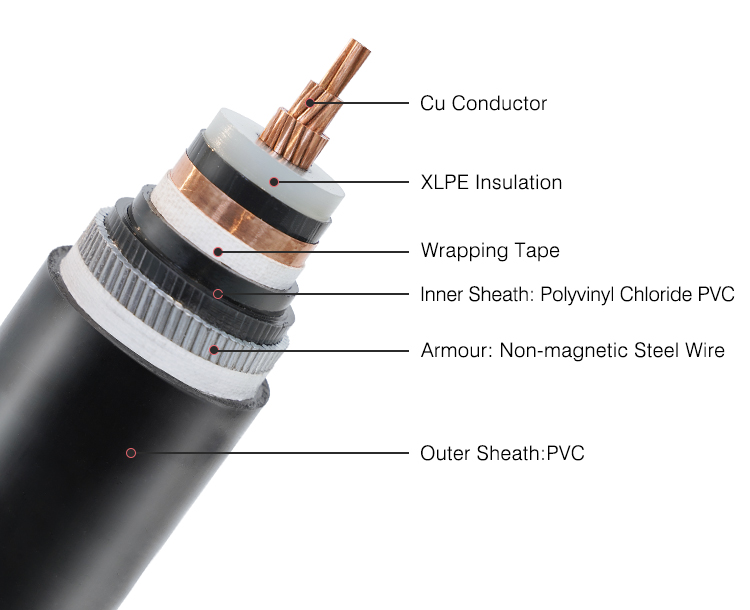2024 Buyer's Guide for Armored Cables: Types, Installation, and Advantages

Exploring Armored Cables
Understanding Different Types
When it comes to electrical wiring, armored cables play a crucial role in ensuring safety and reliability. These cables come in various types, each designed for specific applications and environments. From steel wire armored (SWA) cables to aluminum wire armored (AWA) cables, there are options suited for different needs. Understanding the distinctions between these armored electrical cables is essential for making informed decisions during installations and upgrades.
Cable Types
Understanding Different Types
When it comes to cable types, there are several variations of armored electrical cables available, each with its own unique characteristics and applications. Here's an overview of the various types:
Steel Wire Armored (SWA) Cables: These cables are designed with a layer of galvanized steel wires, offering robust protection against mechanical stress and environmental factors. They are commonly used in industrial settings and outdoor installations where durability is essential.
Aluminum Wire Armored (AWA) Cables: AWA cables feature aluminum armor, providing a lightweight yet sturdy solution for electrical wiring. They are suitable for both indoor and outdoor applications, particularly in areas where corrosion resistance is a priority.
Lead Sheathed Cables: These cables have a lead sheath that offers exceptional protection against moisture and chemical exposure. They are often utilized in harsh environments such as chemical plants and refineries.
Comparing Armored vs. Non-Armored
The advantages of armored cables over non-armored options are significant. Armored cables provide superior protection against physical damage, moisture, and other environmental hazards compared to non-armored cables. Additionally, armored cables offer enhanced durability and longevity, making them ideal for long-term installations in challenging conditions.
By understanding the key differences in performance and durability between armored electrical cables and non-armored alternatives, individuals can make well-informed decisions when selecting the most suitable cable type for their specific requirements.
Cable Installation
Proper Installation Techniques
When it comes to cable installation, following proper techniques is crucial to ensure the safety and reliability of the electrical system. Here's a step-by-step guide to installing armored cables:
Begin by carefully measuring and planning the cable route, taking into account any potential obstacles or hazards.
Use appropriate tools to strip the cable and make clean, secure connections to electrical devices and fixtures.
Secure the armored cables properly, ensuring they are adequately supported and protected against potential damage.
Implement grounding measures as per local electrical codes to enhance safety and reduce the risk of electrical faults.
Safety considerations and best practices during cable installation include wearing appropriate personal protective equipment (PPE), such as gloves and eye protection, and working with a partner when handling heavy or long lengths of cable.
Common Installation Mistakes
Identifying common errors during cable installation is essential for ensuring a reliable and secure electrical system. Some common mistakes to avoid include:
Improper bending or over-tightening of cables, which can lead to damage or compromised performance.
Inadequate support for cables, increasing the risk of sagging or exposure to mechanical stress.
Neglecting proper grounding procedures, which can result in safety hazards and non-compliance with regulations.
By being aware of these common mistakes, individuals can take proactive measures to prevent them during cable installation, ultimately enhancing the overall safety and effectiveness of their electrical systems.
Cable Advantages
Enhanced Protection and Durability
Armored cables offer enhanced protection and durability, making them a reliable choice for various electrical wiring applications. The robust construction of armored cables provides a protective barrier against physical damage, moisture, and other environmental factors. This ensures that the electrical conductors within the cable are safeguarded from potential hazards, thereby mitigating risks and enhancing overall safety in residential, commercial, and industrial settings.
In addition to protection, the durable nature of armored cables contributes to their longevity, reducing the need for frequent replacements or repairs. This not only saves time but also minimizes disruptions to electrical systems, making armored cables a cost-effective solution in the long run.
Long-Term Cost Savings
Exploring the cost-effectiveness of using armored cables reveals significant long-term benefits and potential savings. While the initial investment in armored cable may be slightly higher compared to non-armored options, the extended lifespan and reduced maintenance requirements result in substantial cost savings over time. By minimizing the risk of electrical faults and failures, armored cables contribute to improved operational efficiency and lower overall lifecycle costs for electrical systems.
By prioritizing enhanced protection, durability, and long-term cost savings through the use of armored cables, individuals can make informed decisions that positively impact the reliability and safety of their electrical installations.
Enhancing Electrical Systems
In the realm of electrical wiring, making well-informed decisions is paramount to ensuring safety and reliability. Armored cables play a pivotal role in enhancing electrical systems, offering robust protection and durability. By empowering readers with valuable insights into the world of armored cables, individuals can make informed choices when selecting the most suitable cable types for their specific needs. This comprehensive buyer guide sheds light on the significance of armored cables and their role in bolstering the safety and effectiveness of electrical installations.
See Also
Selecting the Best Cable for Long Span Applications: ADSS vs. Others
Flat Cable with OptiTap: Installation Guide and Advantages
Revealing the Benefits of Pre-Connectorized Pullable Cables
Investigating the Innovative Solution of Precon Cabling
Advantages of FastConnect Fiber Field Assembly Connector for Outdoor Use


